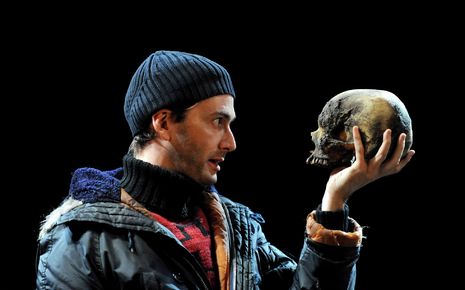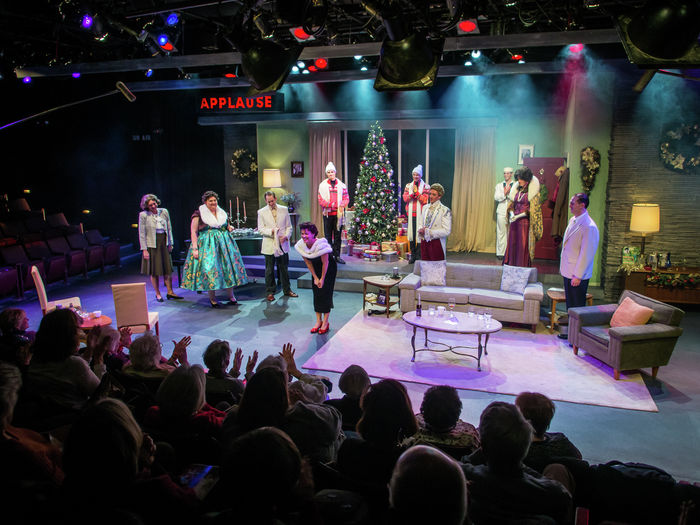To stream or not to stream: Theatre’s new question
Olivia Rhodes explores the complicated implications of streaming theatre, wondering what 2021 will have in store for that liminal moment when the lights dim and curtains lift.

Harold MacMillan claimed that ‘when the curtain falls, the best thing an actor can do is to go away’. This philosophy is a far cry from that which was subscribed to when our own stage curtains fell indefinitely. As the world plummeted into a pandemic, abruptly restrained by national lockdowns, the theatre industry was faced with two options: to retreat into irrelevance, or to orchestrate a new wave of theatre viewing, primarily through broadcasting filmed theatre productions. So began 2020’s answer to theatre – an answer which may not have been universally constructive.
Streamed productions are not exclusively a response to COVID-19. Broadway HD, a Netflix-esque production streaming platform, was founded in 2012; cinema-broadcast events from as prestigious institutions as the National Theatre and the Royal Opera House have long been commonplace. Bonnie Comley, founder of Broadway HD, maintains that filmed theatre is a superlative marketing strategy, as nothing sells tickets like word of mouth. By making shows accessible from a viewer’s own home, the reach of a production expands, in turn provoking conversations which enhance the ‘brand’ [Comley’s term] of a show and the theatre industry in general.
“To film a theatrical production is, in itself, to give us a restricted view seat.”
When ‘Hamilton’ was launched exclusively on Disney+ in July, many signed up for the service just to be able to watch what has arguably been the most revolutionary show in recent musical theatre history. This particular version has especially high value because it immortalises the original cast, including Lin-Manuel Miranda in the eponymous role. This is an advantage of streamed theatre that is not exclusive to ‘Hamilton’; there is indubitably something meaningful about watching the cast who created a show and made it what it is. We feel as if we are returning to a production’s youthful beginnings, where it was a creative dream still glittering with risk and hope and determination, as opposed to something safe, predictable and overfamiliar.
But when, as now, the only way to access theatre is through a filmed production, the benefits of digitalised shows to the theatre industry (and its future) rapidly decrease. It is admittedly inexorable that industry authorities chose streamed productions when live, large-scale theatre became impossible, but the experience of live theatre, for those onstage, backstage, and in the audience, simply cannot be replicated with a filmed production. A massive suspension of disbelief must be bought into for those watching, as we are aware of the intelligence and capabilities of technology – the magical moments of theatre that genuinely elude us can be easily explained away in this context.
“A theatrical performance is distorted as soon as there is a close-up shot.”
Perhaps more harmful, however, are the inevitable compromises that the intricacies of a performance must fall victim to when being adapted for camera. The vision of the production team will be forced to mutate into something appropriate and aesthetically successful for screen, potentially to the detriment of the production’s visuals in its original, theatrical setting. The performance itself is distorted as soon as there is a close-up shot, or there is selective focus on a section of the stage. What makes theatre so unique is the idea of the stage as a whole, eliciting the multiplicity and simultaneous coexistence of action, reaction, and interaction. To film a theatrical production is, in itself, to give us a restricted view seat. As a result, our personal perception of a show we watch on screen will unequivocally suffer: it cannot be our own, and our agency as an audience member is significantly reduced because our focus is manipulated. We are passive subjects at the whim of camera movement.
As productions are filmed, streamed, and broadcast, a concerning conflation of the theatre and film industries develops. With the arts and creative industries already precariously fragile, amalgamating live theatre into film puts the future of the former at major risk of extinction. Multiple productions are being (or have already been) made into films in their own right – ‘Everybody’s Talking About Jamie’, ‘In The Heights’ and ‘West Side Story’ are all slated for release in 2021. While, in my opinion, the film of a show will almost always be inferior to the original theatrical version, at least they orchestrate a separate creative opus: a chance for genuine cinematic readaptation, as opposed to the cannibalisation of a live theatre production.
We are yet to see the definitive impact that the 2020 phenomenon of theatre streaming will have, as theatres remain closed. While we might hope for a surge in ticket sales and a galvanised appreciation for the novelty of live theatre when it is safe for them to reopen, it would be naïve to have unmitigated confidence in this idea. The theatre industry has undergone a change that is potentially irreversible, and contemporary culture craves ease and accessibility, which streamed theatre wholeheartedly supports. Being able to watch a production from home is infinitely more convenient – but theatre should not be about convenience. It is a cultural tradition that dates back to the amphitheatres of Ancient Greece, is its own creative industry that facilitates millions of jobs, and it creates an inimitable form of personal escapism. Theatre is treading water to survive what has been one of its greatest challenges, so it remains our imperative job to save it by attending live performances when they reappear, and to understand that filmed theatre is a substitute, not a replacement. Because, after all, no digitalised production can recreate the liminal moment when the lights dim, the audience hushes, the curtain lifts; and for a second it is just you and the stage, knowing that something wonderful is about to begin.
 News / SU stops offering student discounts8 January 2026
News / SU stops offering student discounts8 January 2026 News / Uni-linked firms rank among Cambridgeshire’s largest7 January 2026
News / Uni-linked firms rank among Cambridgeshire’s largest7 January 2026 Comment / Plastic pubs: the problem with Cambridge alehouses 5 January 2026
Comment / Plastic pubs: the problem with Cambridge alehouses 5 January 2026 News / New movement ‘Cambridge is Chopped’ launched to fight against hate crime7 January 2026
News / New movement ‘Cambridge is Chopped’ launched to fight against hate crime7 January 2026 Comment / What happened to men at Cambridge?31 December 2025
Comment / What happened to men at Cambridge?31 December 2025









